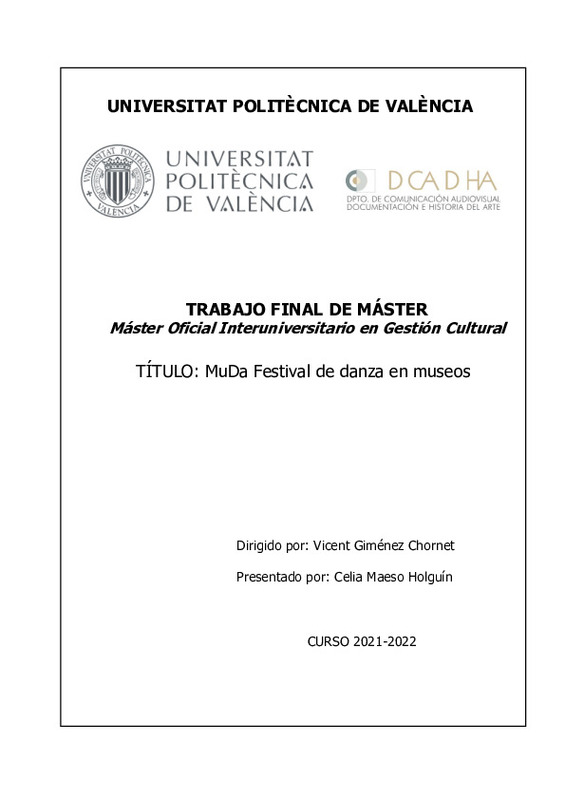JavaScript is disabled for your browser. Some features of this site may not work without it.
Buscar en RiuNet
Listar
Mi cuenta
Estadísticas
Ayuda RiuNet
Admin. UPV
Análisis comparativo del desarrollo turístico en torno al vino y té en Europa y China respectivamente
Mostrar el registro sencillo del ítem
Ficheros en el ítem
| dc.contributor.advisor | Teruel Serrano, María Dolores
|
es_ES |
| dc.contributor.author | Zhu, Xiaorui
|
es_ES |
| dc.date.accessioned | 2022-03-15T09:34:17Z | |
| dc.date.available | 2022-03-15T09:34:17Z | |
| dc.date.created | 2022-02-25 | |
| dc.date.issued | 2022-03-15 | es_ES |
| dc.identifier.uri | http://hdl.handle.net/10251/181438 | |
| dc.description.abstract | [ES] El té y el vino se encuentran entre las bebidas más consumidas en el mundo y son productos ¿gourmet¿ importantes, tanto en términos de producción y comercialización como por su presencia en la vida de los consumidores a nivel mundial. Además, estos productos se encuentran estrechamente relacionados con la cultura y son símbolos identitarios de regiones como Asia o Europa, entre otros. El aprovechamiento de estos productos agrícolas, desde un punto de vista turístico, se inicia con la recuperación y puesta en valor a través de los equipamientos que albergan la producción, sobre todo en el caso del vino, así como en el simbolismo de las tradiciones y rituales en torno al consumo del té en China. En torno a este desarrollo surgen iniciativas consolidadas en los destinos como son las Rutas del Vino en Europa que agrupan y acercan al visitante en el conocimiento del ciclo integral del producto desde el campo, elaboración hasta la degustación. En concreto, estas iniciativas de rutas del vino, surgidas sobre el 1990, cuentan con ejemplos de productos turísticos consolidados en países como Francia, Portugal, Alemania, Italia y España. Sin embargo, el desarrollo de las rutas en torno al té no parece haber alcanzado el mismo nivel de desarrollo y adecuación como producto turístico. Este planteamiento conduce a este trabajo final de grado a analizar la oferta de rutas culturales en torno al té, en China, y las existentes en torno al vino, en Europa, con el fin de compararlas y realizar un diagnóstico que ayude a comprender cuál es el grado de desarrollo alcanzado y a detectar las carencias existentes. | es_ES |
| dc.description.abstract | [EN] Tea and wine are among the most widely consumed beverages in the world and are important "gourmet" products, both in terms of production and marketing, as well as their presence in the lives of consumers worldwide. In addition, these products are closely related to culture and are symbols of identity in regions such as Asia and Europe, among others. The use of these agricultural products, from a tourism point of view, begins with the recovery and enhancement of the facilities that house their production, especially in the case of wine, as well as the symbolism of the traditions and rituals surrounding the consumption of tea in China. Around this development, consolidated initiatives are emerging in destinations such as the Wine Routes in Europe that bring together and bring the visitor closer to the knowledge of the integral cycle of the product from the field, production to tasting. Specifically, these wine route initiatives, which emerged around 1990, have examples of consolidated tourism products in countries such as France, Portugal, Germany, Italy and Spain. However, the development of tea routes does not seem to have reached the same level of development and suitability as a tourism product. This approach leads this final thesis to analyze the supply of cultural routes around tea in China and those existing around wine in Europe, in order to compare them and make a diagnosis that helps to understand the degree of development achieved and to detect the existing shortcomings. | es_ES |
| dc.format.extent | 47 | es_ES |
| dc.language | Español | es_ES |
| dc.publisher | Universitat Politècnica de València | es_ES |
| dc.rights | Reserva de todos los derechos | es_ES |
| dc.subject | Turismo enológico | es_ES |
| dc.subject | Cultural de té | es_ES |
| dc.subject | Recursos turísticos | es_ES |
| dc.subject | Producto turístico | es_ES |
| dc.subject | Ruta cultural | es_ES |
| dc.subject | Vino | es_ES |
| dc.subject | Wine tourism | es_ES |
| dc.subject | Tea culture | es_ES |
| dc.subject | Tourism resources | es_ES |
| dc.subject | Tourism product | es_ES |
| dc.subject | Wine | es_ES |
| dc.subject | Cultural route | es_ES |
| dc.subject | Cultural tourism | es_ES |
| dc.subject.other | Grado en Turismo-Grau en Turisme | es_ES |
| dc.title | Análisis comparativo del desarrollo turístico en torno al vino y té en Europa y China respectivamente | es_ES |
| dc.type | Proyecto/Trabajo fin de carrera/grado | es_ES |
| dc.rights.accessRights | Cerrado | es_ES |
| dc.contributor.affiliation | Universitat Politècnica de València. Escuela Politécnica Superior de Gandia - Escola Politècnica Superior de Gandia | es_ES |
| dc.contributor.affiliation | Universitat Politècnica de València. Departamento de Economía y Ciencias Sociales - Departament d'Economia i Ciències Socials | es_ES |
| dc.contributor.affiliation | Universitat Politècnica de València. Centro de Investigación Arquitectura, Patrimonio y Gestión para el Desarrollo Sostenible - Centre d'Investigació Arquitectura, Patrimoni i Gestió per al Desenvolupament Sostenible | es_ES |
| dc.description.bibliographicCitation | Zhu, X. (2022). Análisis comparativo del desarrollo turístico en torno al vino y té en Europa y China respectivamente. Universitat Politècnica de València. http://hdl.handle.net/10251/181438 | es_ES |
| dc.description.accrualMethod | TFGM | es_ES |
| dc.relation.pasarela | TFGM\143608 | es_ES |
Este ítem aparece en la(s) siguiente(s) colección(ones)
-
EPSG - Trabajos académicos [5004]
Escuela Politécnica Superior de Gandia




![[Cerrado]](/themes/UPV/images/candado.png)



